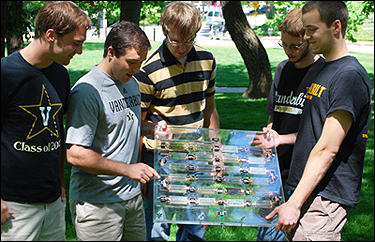Five Vanderbilt engineering seniors will be on the National Mall tomorrow through Monday demonstrating a solar panel that uses spinach to capture and convert the sun’s energy to electricity.
The Vanderbilt team is one of 45 university and college teams from across the country competing in Phase II of the People, Prosperity and the Planet (P3) student-design competition April 21-23 at the 8th annual U.S. Environmental Protection Agency’s National Sustainable Design Expo in Washington, D.C.
 (L-R) Engineering seniors Paul McDonald, Eric Dilbone, Jason Ogg, Trevan Locke and Philip Ingram examine their bio-solar panel. |
The students – Eric Dilbone, Phil Ingram, Trevan Locke, Paul McDonald and Jason Ogg – won a Phase I $15,000 grant in November from the EPA for their bio-inspired solar cell panel. At the public expo, the projects will be judged by a panel of experts and a select few will be awarded P3 Awards and Phase II grants up to $90,000 for students to further their designs, implement them in the field, or move them to the marketplace.
The Vanderbilt team designed a novel, large-scale biohybrid solar panel for power production from many individual photoelectrochemical cells that employ photosynthetic proteins as the active elements for light-harvesting and energy conversion.
Their mentors, Kane Jennings, professor of chemical engineering, and Amrutur Anilkumar, professor of mechanical engineering, challenged the students to scale up a laboratory-proven miniature bio-cell that produces minute electricity from Photosystem I (PSI), the protein in plant chloroplasts that converts light to electrochemical energy.
 An individual bio-solar cell. |
The team extracted PSI from spinach and used it as the working medium in the bio-photovoltaic cells. The two scaled-up panels consist of 24 cells connected in series with each cell measuring 75 x 38 mm. Production of such a scaled-up device has never been attempted before. “They have standardized a production and assembly scheme that can serve as a footprint for future scale up of next generation cells,” said Anilkumar.
“Successful generation of even small amounts of electricity would have far-reaching implications in the quest for cleaner energy,’ says team leader Paul McDonald.
At the expo, the projects will be judged by a panel of experts and a select few will be awarded P3 Awards and Phase II grants up to $90,000 for students to further their designs, implement them in the field, or move them to the marketplace.
“While electrical output will not rival polysilicon-based photovoltaic cells, its manufacturing process may require significantly less electricity and, with further development, could eventually become a perpetual source of energy to run remote sensor networks,” according to Jennings, who is with the team this weekend. “Along the way, the team has demonstrated methods to improve the quantum efficiency of the cells by several folds, which will be the starting point for the next year’s team if the project funding is renewed.”
The expo – opposite the National Museum of American History between 13th and 14th streets – also brings together more than 30 exhibitors from nonprofits and government agencies showcasing innovative environmental solutions.
Previous P3 award winners have started successful businesses and are marketing the technologies in the U.S. and around the world.
Additional event co-sponsors include the American Society of Civil Engineers, Engineers without Borders, Association for the Advancement of Sustainability in Higher Education and Engineering for Change.